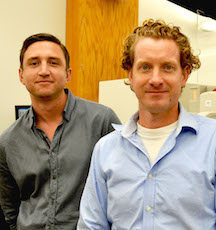Researchers Discover Promising New Anticancer Strategy
Scientists at The Scripps Research Institute (TSRI) have discovered a compound that in laboratory tests irreversibly stops the growth of certain aggressive, treatment-resistant tumor cells. If successfully developed into a treatment, the compound would be the first of a new class of anticancer drugs.
In their study, published in the Proceedings of the National Academy of Sciences, the TSRI researchers showed that the new compound, FiVe1, blocks the growth of tumor cells that have undergone what researchers call the epithelial-mesenchymal transition (EMT), a process common in breast, colon, lung and other epithelial cell-derived tumors—known as carcinomas.
FiVe1 also blocks the growth of tumors called sarcomas, which originate from mesenchymal tissues including bone, fat, cartilage, muscle and blood vessels. The compound blocks cell division (mitosis) by binding to a structural protein, vimentin, that is produced abundantly in mesenchymal-type cells. Drugs that work via this mechanism should spare many of the healthy, fast-dividing cells, such as hair follicle cells, that are harmed by standard chemotherapy drugs.
“We hope that this discovery is going to lead to the development of effective therapies against a broad range of aggressive cancers,” said principal investigator Luke Lairson, Ph.D., assistant professor of chemistry at TSRI.
A Dangerous Cell Type
Mesenchymal cells are one of the major cell types in developing embryos, and ultimately give rise to bone, muscle, fat, and certain other tissues. The EMT occurs naturally in early development to turn some epithelial cells—another broad cell type—into more free-ranging mesenchymal cells. The EMT also can be triggered by inflammation in adult tissues to transform epithelial cells into stem-like mesenchymal cells that aid wound healing.
The vast majority of cancer deaths are ultimately caused by recurrence following therapy or metastases. In previous studies, scientists had demonstrated that the EMT process enables carcinoma cells to adopt the properties of cancer stem cells, namely chemotherapy resistance and the ability to migrate in the body to form metastases.
Researchers have become aware in just the last decade that breast, colon and other epithelial-derived tumor cells sometimes exploit the EMT to detach from a primary tumor and acquire stem-like properties. Whether they originate from EMT-transformed epithelial cells or from mesenchymal tissues, mesenchymal cancer cells are prone to form deadly metastases and are generally difficult to treat with drugs—surgical removal is often the only good option.
The TSRI researchers, including lead author Michael J. Bollong, Ph.D., currently a Scripps Fellow in the Department of Chemistry, discovered FiVe1 by screening a library of about 50,000 small-molecule compounds for activity against EMT-transformed breast cancer cells. The engineered cell line was developed by collaborating researcher Sendurai A. Mani, Ph.D., of M.D. Anderson Cancer Center at the University of Texas. The cells express FOXC2, a transcription factor gene that promotes the EMT and makes cancer cells more stem-like, more prone to metastasis and more resistant to treatment.
One compound performed particularly well at curbing the growth of the FOXC2-expressing cells without affecting non-FOXC2-expressing cells, and had other properties that make it potentially suitable as a small-molecule drug. Follow-up molecular biology studies revealed that the compound blocks mitosis in the FOXC2-expressing cancer cells by binding to a structural protein called vimentin, produced principally in mesenchymal cell types. The compound, in addition to blocking mitosis, caused EMT-transformed breast cancer cells to quickly revert to a lower-grade, epithelial appearance. Lairson and colleagues named the compound FOXC2-inhibiting Vimentin effector 1 (FiVe1).
“Traditional anti-mitosis drugs target proteins such as microtubules that are basic features of the cell division apparatus,” Bollong said. “We’ve shown for the first time here that targeting an intermediate filament protein such as vimentin can also induce ‘mitotic catastrophe.’”
Further lab-dish tests showed that FiVe1 irreversibly blocks mitosis in several other EMT-transformed cancer cell lines, as well as in tumor cells originating from muscle, fat, cartilage and other mesenchymal tissues.
FiVe1’s selectivity for vimentin-containing mesenchymal cancer cells means that it wouldn’t have the same side-effects as traditional chemotherapy drugs. Vimentin is not expressed at significant levels in the hair follicle cells and mouth- and gut-lining epithelial cells damaged by standard chemotherapy drugs. “A drug that blocks mitosis by targeting vimentin should be less toxic than traditional chemotherapeutic drugs that targets cell-division,” Lairson said.
He and his colleagues envision future drugs based on this strategy being used against carcinomas as add-on therapies to suppress EMT-transformed tumor cells that are prone to metastasize. Against sarcomas—tumors that are entirely mesenchymal—anti-vimentin drugs could be primary therapies.
The researchers currently are working to optimize FiVe1 and a few other promising compounds with chemical modifications. With help from a new National Institutes of Health grant they also are screening larger compound libraries to find other potential drug compounds that selectively attack mesenchymal and EMT-transformed cancers. The team plans to begin tests in animal models of cancer once they have an optimized compound.
Other co-authors of the study, “A vimentin-binding small molecule leads to mitotic disruption in mesenchymal cancers,” were Mika Pietilä, Tapasree Roy Sarkar, and Rama Soundararajan of the Mani Laboratory at M.D. Anderson; and Aaron D. Pearson, Insha Ahmad, Costas A. Lyssiotis and Peter G. Schultz of TSRI.
The study was funded by the Skaggs Institute for Chemical Biology and the National Institutes of Health’s National Cancer Institute (grant R01CA200970).
Send comments to: press[at]scripps.edu














